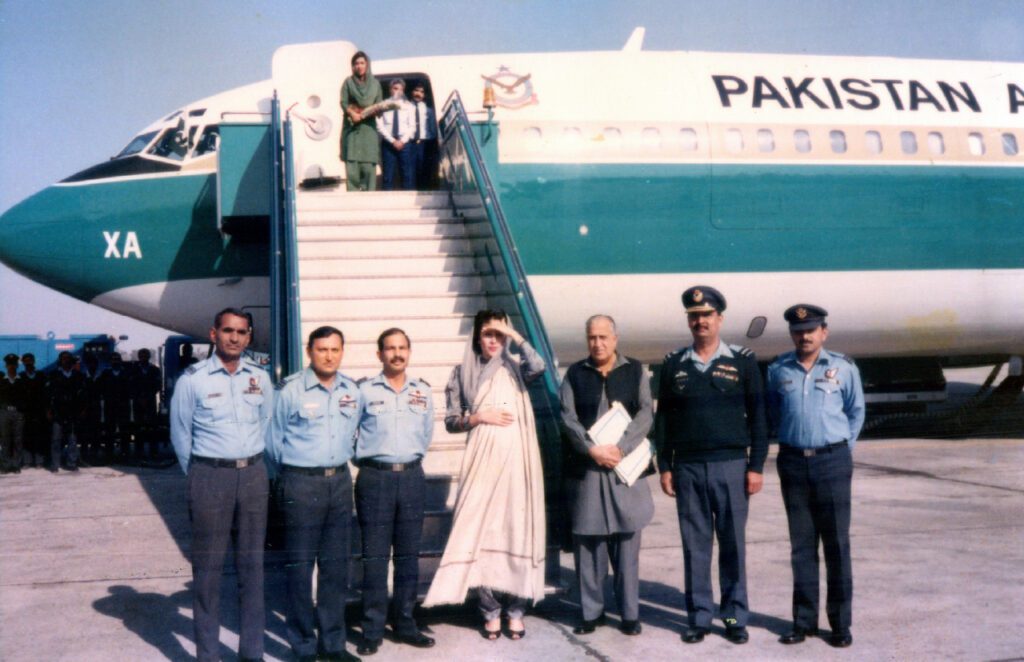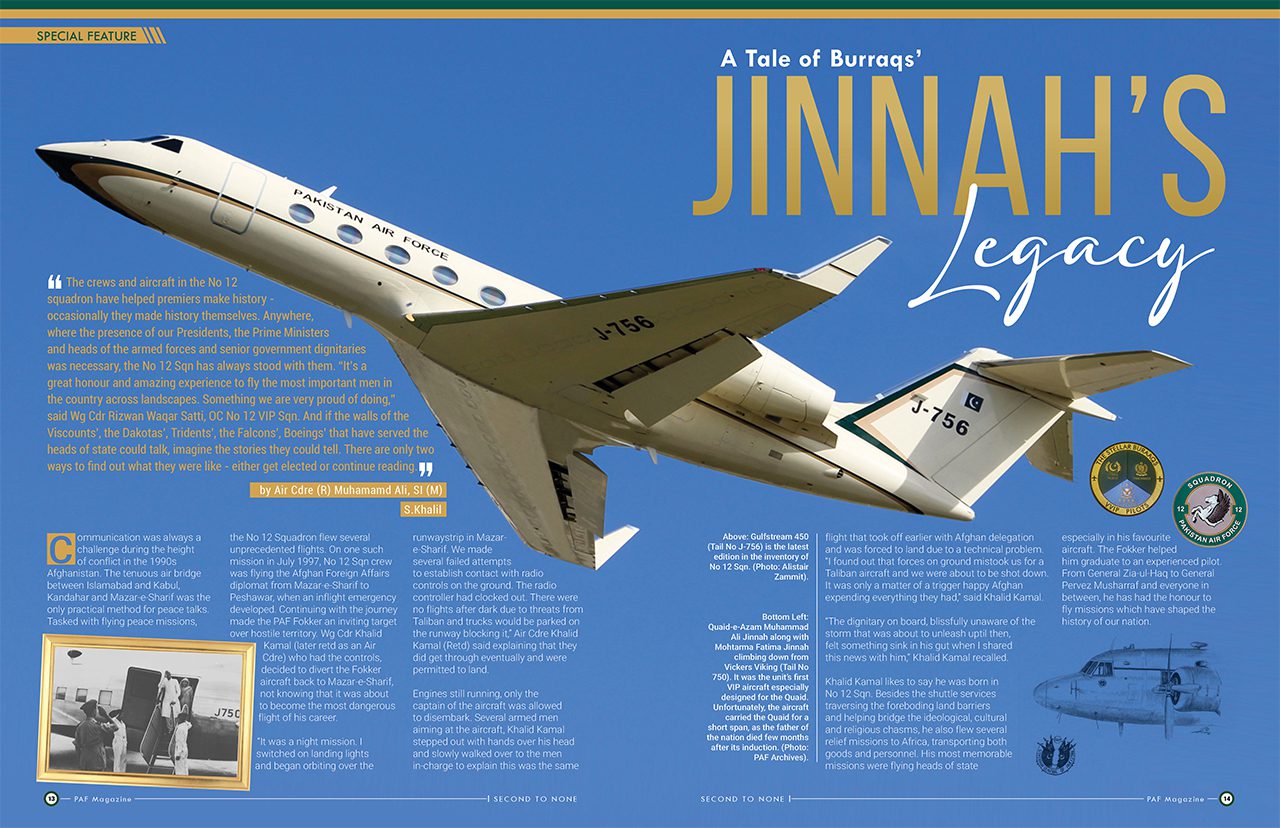The crews and aircraft in the No 12 squadron have helped premiers make history – occasionally they made history themselves. Anywhere, where the presence of our Presidents, the Prime Ministers and heads of the armed forces and senior government dignitaries was necessary, the No 12 Sqn has always stood with them. “It’s a great honour and amazing experience to fly the most important men in the country across landscapes. Something we are very proud of doing,” said Wg Cdr Rizwan Waqar Satti, OC No 12 VIP Sqn. And if the walls of the Viscounts’, the Dakotas’, Tridents’, the Falcons’, Boeings’ that have served the heads of state could talk, imagine the stories they could tell. There are only two ways to find out what they were like – either get elected or continue reading.
Communication was always a challenge during the height of conflict in the 1990s Afghanistan. The tenuous air bridge between Islamabad and Kabul, Kandahar and Mazar-e-Sharif was the only practical method for peace talks. Tasked with flying peace missions, the No 12 Squadron flew several unprecedented flights. On one such mission in July 1997, No 12 Sqn crew was flying the Afghan Foreign Affairs diplomat from Mazar-e-Sharif to Peshawar, when an inflight emergency developed. Continuing with the journey made the PAF Fokker an inviting target over hostile territory. Wg Cdr Khalid Kamal (later retd as an Air Cdre) who had the controls, decided to divert the Fokker aircraft back to Mazar-e-Sharif, not knowing that it was about to become the most dangerous flight of his career.
“It was a night mission. I switched on landing lights and began orbiting over the runwaystrip in Mazar-e-Sharif. We made several failed attempts to establish contact with radio controls on the ground. The radio controller had clocked out. There were no flights after dark due to threats from Taliban and trucks would be parked on the runway blocking it,” Air Cdre Khalid Kamal (Retd) said explaining that they did get through eventually and were permitted to land.
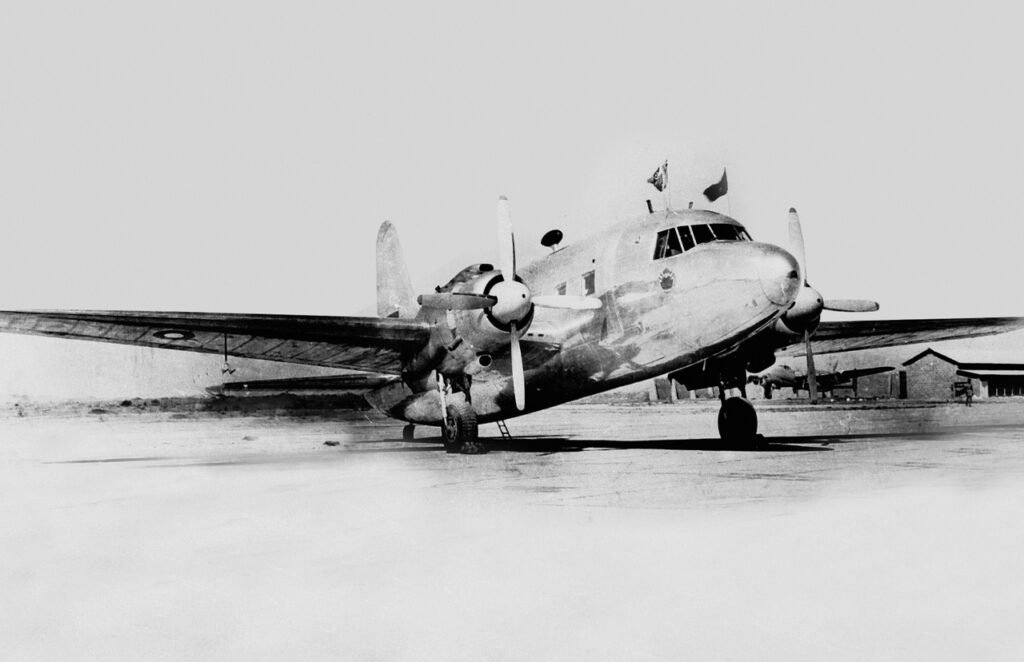
Engines still running, only the captain of the aircraft was allowed to disembark. Several armed men aiming at the aircraft, Khalid Kamal stepped out with hands over his head and slowly walked over to the men in-charge to explain this was the same flight that took off earlier with Afghan delegation and was forced to land due to a technical problem. “I found out that forces on ground mistook us for a Taliban aircraft and we were about to be shot down. It was only a matter of a trigger happy Afghan expending everything they had,” said Khalid Kamal.
“The dignitary on board, blissfully unaware of the storm that was about to unleash uptil then, felt something sink in his gut when I shared this news with him,” Khalid Kamal recalled.
Khalid Kamal likes to say he was born in No 12 Sqn. Besides the shuttle services traversing the foreboding land barriers and helping bridge the ideological, cultural and religious chasms, he also flew several relief missions to Africa, transporting both goods and personnel. His most memorable missions were flying heads of state especially in his favourite aircraft. The Fokker helped him graduate to an experienced pilot. From General Zia-ul-Haq to General Pervez Musharraf and everyone in between, he has had the honour to fly missions which have shaped the history of our nation.
The one mission he talks about often, for which then President Farooq Leghari owes him a case of beer, was a flight back from Australia. Shortly after taking off, the No 3 engine of VIP B-707 tail No 635, flamed out, also rupturing a fuel tank. “The engine quit but luckily the plane did not plummet,” he said as his mind went back to training, in the time of crisis. Without letting the fears of the moment overcome his rational judgement, Khalid Kamal landed the Boeing safely back at Darwin.
There are many symbols of power in the Pakistan Air Force but none show more strength than the No 12 Sqn. When Gulf Stream 450, a pinnacle of speed with comfort, pulls up to the spot for arrival, when the door is opened and the premiers’ step out, it symbolizes the strength of the country. Behind every journey, whether in prop planes or modern jets, there has been an extraordinary team tasked with transporting our leaders. The No 12 Sqn has assisted PMs conduct foreign policies across the world in veritable air force workhorses. Its crews and their planes have played parts in our profound national dramas. From Jinnah’s last air journey and tragic death recorded in the flying log book of Sqn Ldr RJ Harrison (Officer Commanding Governor General’s flight), to opening up the world for President Ayub Khan, to transporting relief goods where they were needed the most to airlifting Pak Army troops for UN special missions across the world, No 12 Sqn and his crew has always proved itself equal to the task.
Prime Minister Zulfiqar Ali Bhutto was the regular passenger of Sqn Ldr Sardar Asif (later retd as AVM). On one particular tour when it was chucking down with rain, a young pilot Sqn Ldr Sardar Asif, was tasked to fly Zulfiqar Ali Bhutto to Quetta on an important assignment the premier couldn’t afford to miss.
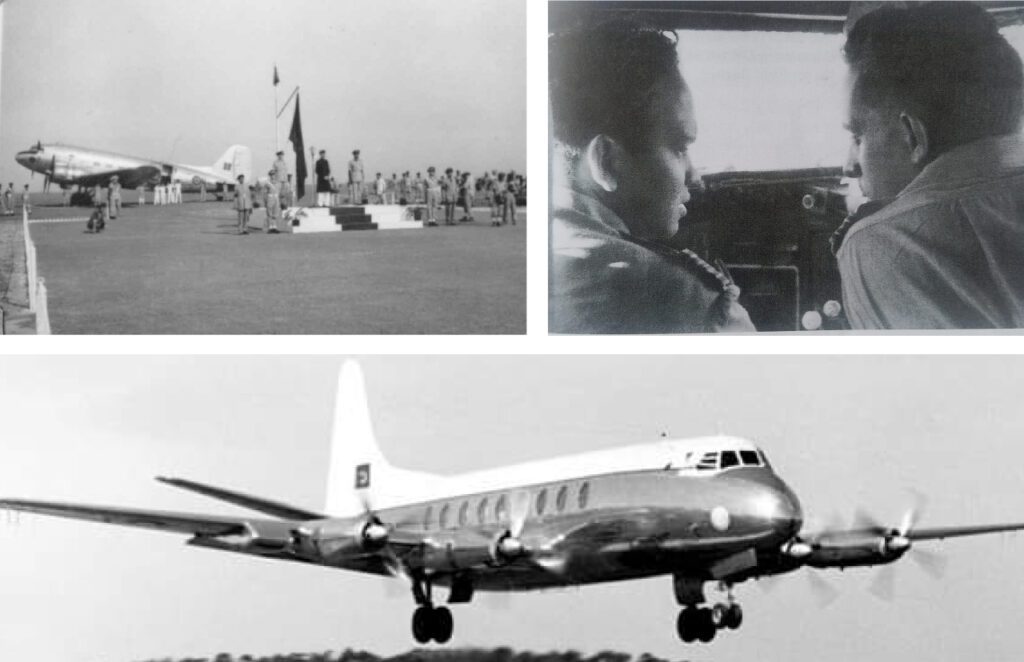
“It can be a dreadful flight in an overcast conditions to Quetta, in a Fokker aircraft that does not have the luxury of climbing to high altitudes to avoid weather. Throughout the flight the weather was really bad, it became worst as we approached our destination. As soon as I broke the clouds during descent, I realized that we were only 500 feet above ground, too low for comfort,” he recalled the unforgettable event that he never says much about. Had he continued descending, the plane could have hit the ground in less than 30 seconds.
Walking through a flying squadron is pretty cool and this one can get anyone excited. The history and heritage of the No 12 Sqn extends quite a way back. In the squadron memorabilia’s lining the walls of sqn headquarter building, complete with polished marble floors, gives a sense of how incredible were the crews that made up the No 12 Sqn.
“Carrying VIPs since the 1940s and having transported prime ministers and presidents, air force, army and naval chiefs and high level officials, is an almost indescribable experience until you’ve done it”, Wg Cdr Ali Akbar Flt Cdr Operations No 12 Sqn said.
“We’re always there always standing by whether we are needed or not. This is the job of No 12 Sqn, a military mission that never ends. The moment of truth comes when flying a high profile dignitary such as Pakistan 1, which is the VIP aircraft call sign for the President of Pakistan. We try not to be overwhelmed with it because we have a job to do and stay focussed,” Ali Akbar explained.
While the No 12 Sqn has played critical role in transporting the Prime Ministers and his staff to events and engagements across the world since the times of Quaid-e-Azam Muhammad Ali Jinnah, the aircraft have matched the leadership role. However, long before the PAF was sending premiers across the globe in the comfort of modern flying offices that they use today, chief executives got by in less efficient modes of transportation. Aircraft like the Viking and the Viscount, represented the quality of comfort back then.
Taking a look at No 12 Sqn’s humble beginnings, its story began in June, 1948, when it was just a communication flight stationed at Mauripur (now PAF Masroor). The flight was equipped with specially appointed Viking, PAF’s first aircraft that came fitted with luxury upholstery for VIP flights. It was called the Governor General’s aircraft, and was meant exclusively for him. As a bonus, it was also beautiful. Since there was no RPAF pilot with sufficient experience to undertake VIP flights, an RAF officer was the Viking’s sole pilot and the commander of the Governor General’s Flight. Before the arrival of Viking, the Governor General Quaid-e-Azam Muhammad Ali Jinnah flew on special VIP version of Douglas Dakota. It was this aircraft that carried the Quaid to RPAF Risalpur on 13 April 1948, where he delivered the famous speech of PAF being the Second to None. All the VIP version Dakotas and Viking carried the seal of the Governor General on the nose of aircraft underneath the pilot side windshield. While taxiing, the aircraft showed Pakistan colour and Governor General flag whenever it carried the Governor General on board.
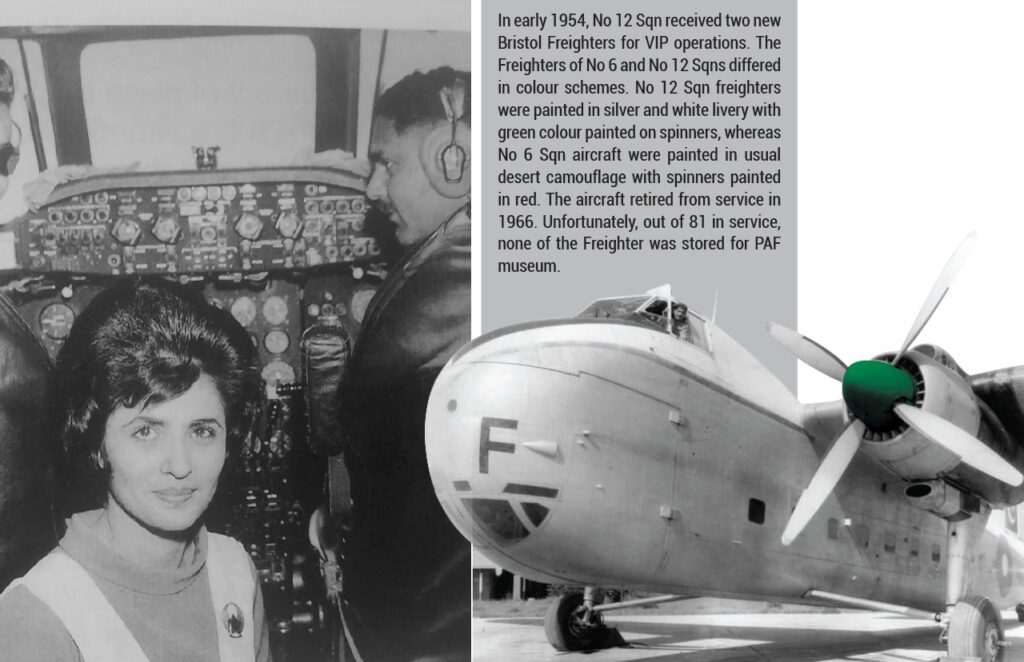
The PAF inherited a few Auster aircraft in August 1947, which were meant primarily for training of air observation post (AOP) pilots of the army. However, in the absence of any special aircraft for light communication duties, some of these Austers were harnessed into this role. Together with a stray Fox Moth and a couple of Harvards, a Communication flight was formed in March 1948, which serviced the bulk of the RPAF’s light communication needs till the early 1950s. In 1953, this flight was made part of No 12 Composite Squadron. A De Havilland Dove had also joined the light communication aircraft inventory three years earlier and the Austers and Harvards gradually faded out.
During the period from 1947-49, one of the Dakota (tail no C-406) of No 1 Communication Flight was modified for the then Commander-in-Chief of RPAF, AVM Atcherley, to provide an office, a sleeping compartment, working space for steward and ground crew and about half a dozen passenger seats. In the crew compartment the navigator’s area was used for installing a fuel tank that would allow the aircraft to fly direct from Karachi to Dacca. AVM Atcherley being a bachelor spent most of the time in the aircraft, flying from air station to air station, working late nights and even conducting Court Martials in the aircraft. When flying to Dacca, he used to arrive at the station the night before at 10 PM, get into the aircraft, put on a white coverall and go to sleep. The aircrew had the standard briefing to carry out the pre-flight checks and take off the next morning without disturbing the C-in-C. Such were the early days in the nascent RPAF which appears to be from another world in the present times.
No 12 Sqn was formed in March 1950, with Sqn Ldr AKS Ahmed as its first commanding officer. It was the first heavy bomber squadron with eight Halifax 4-engined WWII bombers and started flying on April 5 with two MK VIII and six MK VI aircraft. In September, 1953, the unit was converted into No 12 Composite Squadron with Sqn Ldr Mukhtar Dogar as its first officer commanding. It was assigned a variety of tasks including VIP and Air Headquarters communication flights on Viking and Dakota aircraft, target towing for ack ack on Furies, and heavy bomber operations on Halifaxes.
In early 1954, the squadron received two new Bristol Freighters followed soon after by two Wayfarers and two Tempests. Everything was analogue and that vintage vibe continued throughout the airplanes. In May a Freighter, especially equipped for para-trooping role, was added to the fleet.
In April 1956, a Viscount aircraft replaced the aging Viking. However, the Viscount did not last long. Developing structural weaknesses after a few years of service, PAF retired the aircraft. A little later, the PAF selected a VIP version of the F-27 aircraft when Pakistan International Airlines, decided to acquire several of this type for its domestic networks. In the mid-60s, a need was felt to have a larger, long-range aircraft for the President. Since PIA had already bought some Tridents, another Trident, in VIP Configuration, was acquired by the PAF. To ensure maximum utilization of this large and expensive aircraft for public benefit, the President directed that the Trident be transferred to PIA for regular use.

February 1957, saw the squadron flying its newly acquired SA-16 Albatross maritime aircraft in a sea rescue exercise. The SA16s, which were primarily meant for search and rescue, were equipped with
special search radars and had exceptionally long endurance. In August 59, SA16s participated in exercise Jet North, with the navies of the UK and New Zealand.
Finally, on 9 July, 1960, the entire air transport element of the PAF’s – No 3, 6, and 12 squadrons was moved from Mauripur to Chaklala, where it was equipped with a Fokker F-27 aircraft for the use of VIPs and visiting dignitaries. Since then, the No 12 Sqn became another arm of the air force and the base has remained the hub of all peacetime military air transport activity in Pakistan.
In 1972, the Prime Minister, having seen the Agha Khan’s Gulfstream aircraft, indicated his preference for a similar aircraft. After comparative analysis of several types, Air Headquarters selected the French Falcon DA-20. However, its limited fuel capacity severely restricted its non-stop range. Nevertheless, both the F-27 and the Falcon provided safe and timely VIP service over the years. After completing ground and flight training in this modern aircraft, Wg Cdr Sardar Asif was the pilot-in-command who flew the first ferry of DA-20 from France to Pakistan. Another interesting aspect of this maiden flight was that the then Commander-in-Chief of PAF, Air Marshal Zafar Chaudhry who was on a routine visit to France chose to fly back on this aircraft.
Most VIP transport propeller planes in the PAF inventory were the WWII piston engine designs. They were slower, and its passengers all the while endured noise and vibration especially during those white-knuckle rides through rough weather. Their careers, overlapped into the jet age and the appearance of rapidly developing new technologies, brought down premature curtains on their lifespan. The difference between the first piston engine VIP aircraft and the advanced jets of today is like night and day. They have cut flight hours, can fly above the weather and are more fuel efficient.
Today, two Gulf Streams and a Citation-XL are the latest in a series of jet powered aircraft that make up the No 12 VVIP Sqn. Entering service in 2005 and 2007, these jets are the newest in an evolution that began with the Viking and the Viscount aircraft to take heads of state aloft.
The PAF is responsible for operations of all three. Pulling the world closer than ever, they represent a new level of flying comfort for the premiers, with an impressive serviceability rate. Fitted with twice as powerful Rolls-Royce engines, streamlined wings, and better cabin area, plush seating, exotic looks, they leave prop planes far behind. Keeping ahead of the technology curve, these jets have large iPad looking touch screens, and zoom like an arrow through the sky for nine hours plus non-stop. With more style and substance over their predecessors, these executive jets, with the white livery and proudly displayed words Pakistan Air Force on the fuselage, are the most recognisable at the Nur Khan Air Force base.
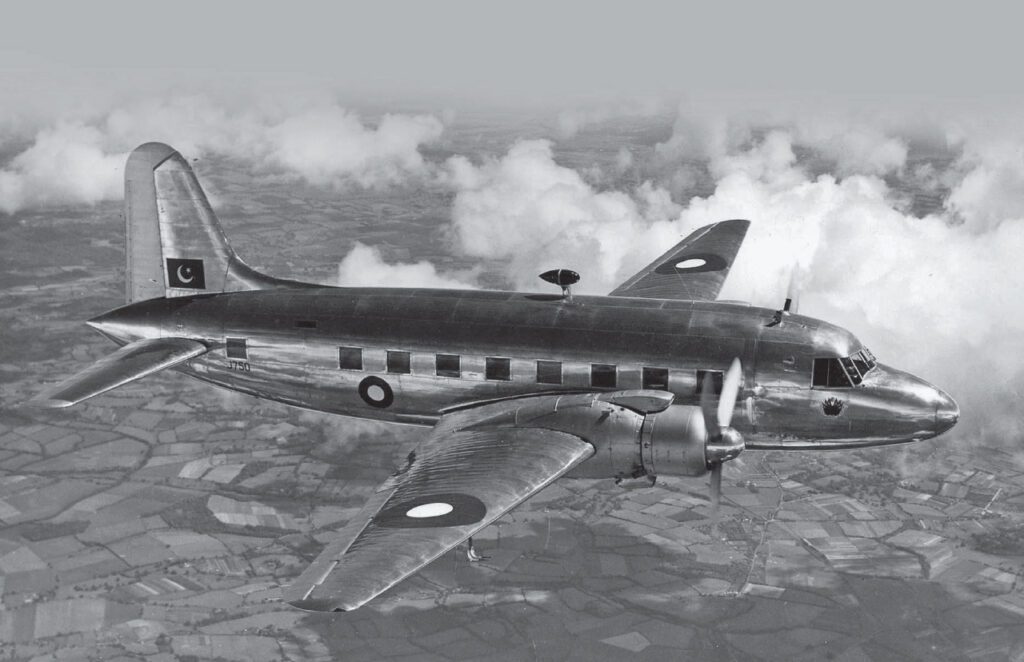
In the office, the Gulf Stream holds two pilots up front. Quite often, they miss their flight engineer and especially the navigator. He’s the guy who determines the route. He was someone all Gulf Stream and Citation pilots were used to having around in the cabins of the C-130 and other bigger planes before transitioning from the transport sqn to the VIP Sqn.
No 12 Sqn is on alert 24/7, because it is a 24/7 ops mission, said Wg Cdr Rizwan Satti, Sqn Commander No 12 Sqn. “Missions are no child’s play, very demanding especially when flying the Air Chief with call sign Shahbaz 1. It’s also the time for the team to earn its stripes. The Air Chief is an experienced pilot himself and so are his staff officers on board. They second guess every move, every decision we take. They can ask you anything – the distance to the nearest landing strip, names of countries to the south of the Caspian Sea, why the particular light is flashing, cities, runways and coordinates etc etc,” said Wg Cdr Rizwan.
Even though the crew walks into work every day with a smile because every flight is a special mission, gravity of the job really hits home when they are readying the aircraft and then suddenly see the PM getting out of his car and walking towards the plane.
“It makes you sit up straight and take the job a little more seriously. It’s not combat stress. Not worrying about providing air support. It’s about supporting the most important person. It was an unforgettable moment of pride etched into memory the first time I announced over the radio that Pakistan 2, which is the call sign of the Prime Minister, is ready to fly,” said Wg Cdr Rizwan.
Then there are those astonishing expressions of the faces of our country’s leaders when they see they are going to be in the hands of young Squadron Leaders and even younger Flight Lieutenants. “They are used to seeing rather more grey-haired pilots on commercial flights,” said former No 12 Sqn Cdr and a Falcon pilot, AVM Haseeb Gul, especially when he used to fly them into conflict zones to Afghanistan for pivotal meetings. However, with passage of time when they closely observed PAF pilots’ professionalism and more importantly their conduct, they realized that they were in safe hands.
Only the best pilots from the transport wing have the privilege to fly the executives. After years of rigorous training in transport fleet, only the best of the best qualify to serve in the No 12 Sqn. Equally important is the job of the air steward on board VIP flights. Besides luggage handling, he is also responsible to ensure safety protocols are in place in case there is an emergency.
In last years of string of perfect touchdowns, No 12 Sqn have most dutifully transported premiers with pride. For the handpicked aircrew entrusted with the responsibility to carry the premiers on board, it has been an honour none of them can ever forget. They describe the task of keeping the executives soaring through the skies as the best job in the world.
